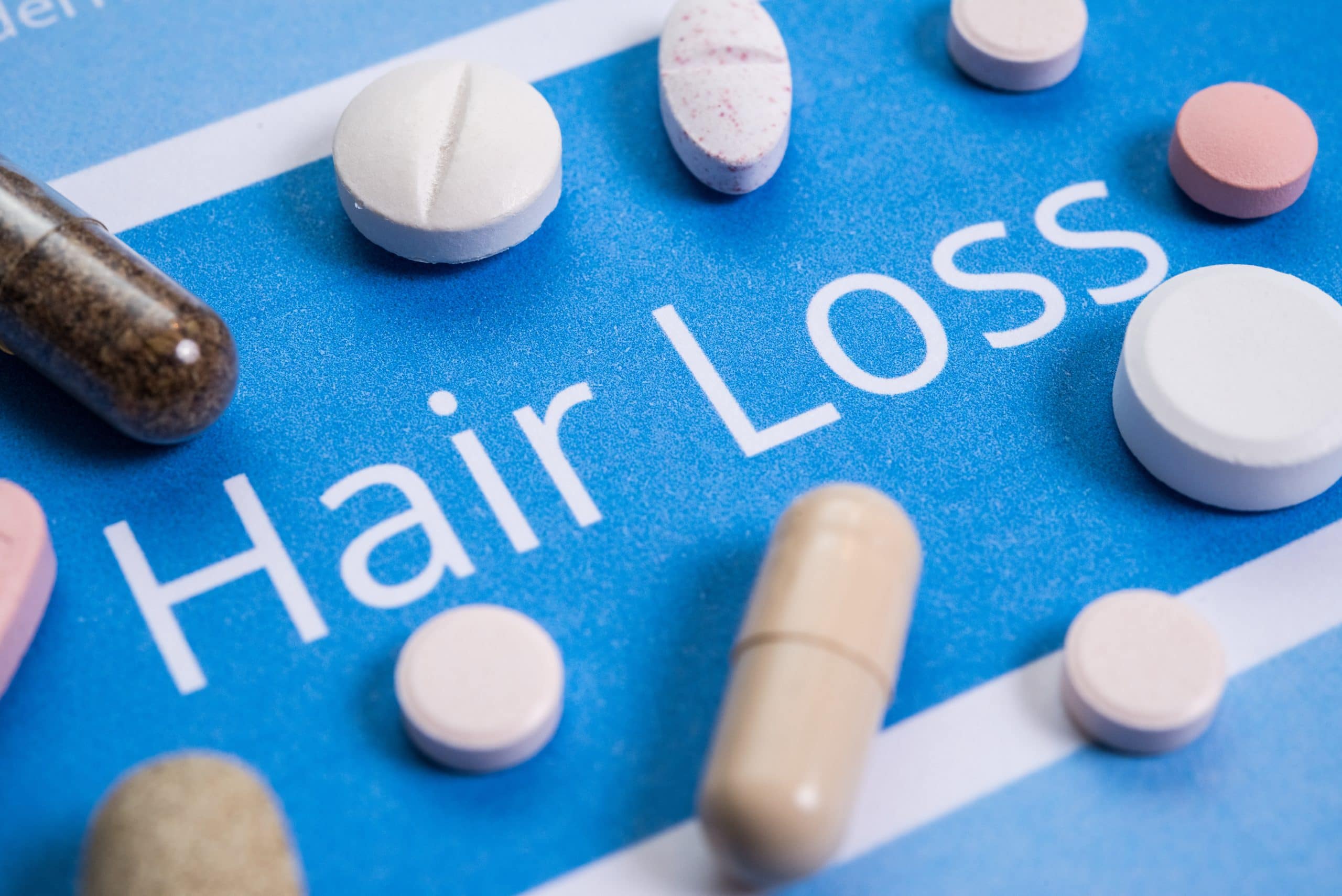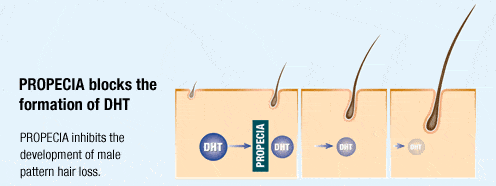
Hair Loss Medications: Types, Effectiveness, and Side Effects
- March 16, 2022


The past two years have been a ride that we were all taken (very unwillingly) on. COVID-19 reared its ugly head and trampled into the 21st Century, leaving behind a world that is now incredibly different. One of the unfortunate results of this is an increase in those experiencing hair loss, for maybe quite different reasons than you would have believed. Since the emergence of COVID‐19, most of the news attention has been on the worrying and life-threatening respiratory and cardiovascular effects. However, there are studies done showing that other manifestations of the disease have appeared and remained long after an active infection has been gone, impacting the lives of its sufferers.
One such symptom is the onset of diffuse hair loss in patients previously infected with COVID-19 that has been shown to be clinically compatible with telogen effluvium (TE). Telogen effluvium is characterised by diffuse hair loss within months of a significant stressor, such as an illness, because of the premature transition of the hair follicles from the anagen phase (active growth phase) to the telogen (resting or hair shedding phase).
Also Read: Frequently Asked Questions About Hair Loss In Singapore
The cycle of hair growth helps to explain things better. There are three main phases in the hair cycle, with the anagen phase lasting the longest for about 2-6 years. This is the stage where our hair has the most opportunity to grow if we provide it with a good internal and external environment to flourish! The catagen phase is merely the transition phase, lasting 1-2 weeks, where the hair follicle begins to get ready to enter the telogen phase. The telogen phase lasts 5-6 weeks and is where the hair starts to detach itself from the base of the hair follicle (dermal papilla).
In telogen effluvium, many more of our hairs are shifted into the telogen phase, causing a lot more hair shedding as well as worries. As mentioned before, telogen effluvium can happen from stressful events increasing cortisol and triggering that shift into telogen phase, hormonal changes such as during a woman’s postpartum or menopause stage, or even as a scalp reaction to chemicals that were unsuitable. Telogen effluvium can usually be identified by its diffuse nature across the scalp instead of a hair loss that concentrates initially over the middle hair parting (in women), or by a receding hairline (in males).
That form of hair loss where it may look different in males and females is different from telogen effluvium. It is called androgenetic alopecia, or male/female pattern baldness. In males, this process is generally driven by hormones and genetics. Male sex hormones (more specifically, testosterone) are carried in the blood to the hair follicles where they are converted into di-hydrogentestosterone (DHT). This DHT causes the hair follicle to undergo miniaturisation and hair thinning.
In females, it may not be primarily led by the same hormones as found in males, but it may have a combination of factors like genetics, hormones, stress, or nutrition. Although hormones may not play the same role in female pattern hair loss as in males, a scalp examination will show the same miniaturisation process. This miniaturisation means that the hair follicles become smaller and shallower, and the hair shaft gets progressively shorter and finer due to long-term damage from DHT.
Male and female hair loss that is caused by androgenetic alopecia will also look different. Male pattern hair loss usually appears first with a receding hairline, or a circular thinning patch at the top of the head. Female pattern hair loss will look more like a thinning that begins over the middle parting vertically at the top of the head which becomes more diffuse over time, revealing more and more of the scalp along the way. Either way, the hairs will begin to look thinner and wispier and begin to shed quicker without any regrowth.
Since we are accustomed to seeing about 50 to 100 hairs being shed everyday, when we start to shed even more and see more hairs being stuck in our hair brush or shower drain, we start to Google whether we need to start seeing a doctor or begin taking any supplements to stop hair loss in its tracks. With all the wealth of information online, it can be hard to know what to do – hair loss medication types like minoxidil and finasteride? What about the hair loss medication side effects? How do I know which one is right for me?
If that sounds a lot like your own internal monologue, read on because we are going to explain:
Among common hair loss medications are minoxidil, finasteride, spironolactone, and dutasteride.
Minoxidil is also known in the markets as Rogaine. It is a topical application, meaning that you apply a solution which can be in liquid or foam form onto the hair thinning areas. It can appear in 2% or 5% concentrations. A study in 2002 showed that 5% minoxidil showed significant results in males with male pattern hair loss compared to 2% minoxidil after 48 weeks, and also showed an earlier response to treatment. If you see a bottle of Rogaine on the pharmacy shelves, you may notice a little sign indicating “For Men Only” on it. Don’t worry. Minoxidil was initially only approved for men’s use, but the FDA has also cleared it for women as well. Not just for those experiencing androgenetic alopecia, minoxidil can also be very helpful for those experiencing telogen effluvium.
Finasteride (also known as Propecia) is a hair loss medication that is oral instead of topical. It comes in a pill form, taken once per day, and is also FDA-approved to help treat hair loss caused by androgenetic alopecia. Finasteride is a prescription medication, meaning that you’ll need to talk to a healthcare provider and receive a prescription for it before being able to purchase it. In males experiencing male pattern baldness, Finasteride has been shown to reduce hair loss in 66% of men who underwent a 12-month trial.
Spironolactone (Aldactone) is usually prescribed for female pattern hair loss, and is typically prescribed for females when minoxidil doesn’t seem to work; however, both medications can be combined for increased benefits. One 2017 study showed that a combination of spironolactone and minoxidil provided the benefits of reduced hair loss, and increased growth and density. For those only on Spironolactone, it has also been shown to help females experiencing female pattern hair loss from a variety of hormonal dysfunctions by either preventing further loss of hair, or by increasing hair growth.
Dutasteride (commonly sold under the name Avodart) and is similar to finasteride in the sense that it works the same way (Read more on how they both work in the next section). The main difference is that finasteride is an older medication, being approved in 1997 for hair loss treatment, and dutasteride was approved in 2001. Both finasteride and dutasteride were clinically shown to increase hair growth in men with male pattern baldness over 24 weeks.
Minoxidil works by widening and increasing the blood vessels in the scalp, increasing blood flow to your scalp and hair follicles. Since nutrients are sent to body tissues by blood, the increased blood flow to hair follicles helps to provide more nutrients to the hair for healthy growth. Minoxidil also helps to shorten the telogen (resting) phase of your hair cycle and shifts the hairs into the anagen (active growth) phase, encouraging more growth.

Finasteride and dutasteride work in the same way for male pattern baldness – they block the production of di-hydrotestosterone (DHT) in the hair follicles. They work by inhibiting the 5-alpha-reductase enzyme which is responsible for converting testosterone into DHT. By blocking 5-alpha-reductase, DHT levels drop and slows down its effect on the hair follicles (namely miniaturisation, which is the shallowing of the hair follicle which causes hair to thin and fall out).
For women, finasteride or dutasteride may not work as well, and spironolactone has been shown to be effective in females. Spironolactone slows down the production of androgens, which are male sex hormones including testosterone. Most people need to take it for at least six months up to a year before they start seeing results, hence it is typically combined with other treatments like minoxidil or in-clinic scalp treatments (e.g. Regenera Activa Scalp treatments).
Spironolactone is usually prescribed for female pattern hair loss caused by excessive androgen production, which has a similar mechanism to DHT in the hair follicles, and can also help those experiencing hair loss from polycystic ovarian syndrome (PCOS).
All of these are prescription medications, and for good reason. There can be unpleasant hair loss medication side effects if not taken with the proper guidance, and a doctor can monitor if you are having a reaction to any medications.
Minoxidil is a Category C danger to those who are breastfeeding or pregnant, which means that although not proven to be harmful to the baby, there has not been enough research done to completely rule out any effects.
Otherwise, in the general population, Minoxidil’s most common side effect is scalp dryness/irritation. If you notice an increase in facial hair as well, it may be because some application of minoxidil has accidentally been transferred to your face. For some people, minoxidil can cause a lower blood pressure as it is a vasodilator and works by relaxing blood vessels so that blood can pass through them easier. This can result in dizziness or a light-headed feeling.
Spironolactone should be stopped 1 month before trying for a baby, as it is a Category D danger, meaning that females definitely should not take this pill if they are pregnant or trying to get pregnant as it may cause birth defects. However, there is no concern for a long-term risk of birth defects once you have stopped the spironolactone.
Medications like Spironolactone can also cause drowsiness for some people, and is recommended to be taken at night. It may also cause low blood pressure since it is also used in lowering blood pressure. Since it is anti-androgenic, it may cause some menstrual irregularities and breast tenderness in females.
Finasteride and dutasteride are androgen blockers, hence their side effects will relate mostly to the male reproductive system. Among them are erectile dysfunction, decreased semen volume, testicular pain, or a reduced libido. Although it sounds rather serious, only 1.2-1.8% of men on finasteride reported side effects related to sexual dysfunction and those side effects may become less common over time.
Before starting any medications, always consult with your doctor. You may be taking other medications or supplements at the same time, which could have a negative effect on your body if the combination of all those medications does not go well together. This is called ‘poor medication interactions’, and can result in some serious side effects. For example, spironolactone may worsen kidney function in those taking potassium or blood pressure/heart medications. A doctor can help to assess your medications to check for their interactions.
Additionally, it is always a good idea to contact a doctor whenever you have doubts about whether a medication is suitable for you or not. If you have started on medication and have begun to experience hair loss medication side effects that are painful, uncomfortable or worrisome, that’s a sign that you should contact your provider instead of keeping quiet about it.
There are options to switch medications and treatments to something that is more suitable for you. If you have been already on a particular hair loss medication for at least 6 months and have not experienced any changes in hair loss effects, you may also want to contact your doctor to discuss other suitable treatment options.
Just as how we normalise taking care of our appearance, let us also normalise taking care of our health by speaking up and advocating for ourselves whenever undergoing any form of treatment plan, including a hair loss treatment programme. At SL Aesthetic, our team of friendly doctors are always ready to assess, explain, and treat – we’re just one call away.
Like what you read? Share them!